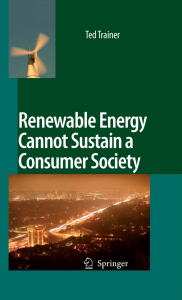trickle down
Energy, global warming, and the environment – it’s all in the news but progress on the ground is pedestrian at best.
At the stratospheric level there seems to be an agreement to do something sometime coming out of Cancun. The positive spin is that an agreement has been reached; the real impact is less clear. Here is The Guardian summary and here the official UN site.
At a slightly lower level the December 2010 issue of the Atlantic carries the lead article “Why the future of clean energy is dirty coal” by James Fallows. The title sets my teeth on edge (as it is intended to), but the article is a persuasive analysis and argument. The key points that struck me:
- China is learning by doing; building modern coal fired plants and gaining knowledge, while it takes decades to get a permit to build in the US. Not in the article, but a clear extension, is that many countries are “learning by doing” alternative energy – see my many references to Germany and Australia, and my blog on Portugal. While in the US we seem happy to just do things incrementally better or not at all. It reminds me of the willful refusal to change car design by the Big 3 in 70’s and 80’s in the face of Japanese success. Sure, the Big 3 stayed big for decades, but eventually reality caught up with them. As it will on the energy front.
- The numbers are huge, and the hurdle for the US is the largest. Fallows quotes a climate scientist: “To stabilize the CO2 concentrations in the atmosphere, the whole world on average would need to go down to the Kenya level [of carbon emissions]” – which is a 96% reduction in per capita emissions for the US.
Fallows refers to David MacKay’s “Sustainable Energy- Without the Hot Air”, which I cite a number of times on these pages. While I very much endorse MacKay’s approach and findings, the specifics are for the UK. Sometimes that makes the problem seem even larger than it is for a sun-rich country like the US. Fallows quotes some UK statistics like “if the windiest 10% of the entire British landmass were completely covered with wind turbines, they would produce power roughly equivalent to half of what Britons expend merely by driving to work each day”. But without doing the math (something that Mackay urges continually) we can’t know how this applies to another country.
The MacKay approach has been used by Dr. Peter Seligman of the University of Melbourne to generate an Australian specific version, and it should really be done for the US as well. [Would anyone like to sponsor my sabbatical?] Although this book by Ted Trainer may get close – more comment once I have read it (It is available to read online).
If wading through Mackay is too much here is a BBC interview he gave in 2009.
By the way, and so I keep an even approach, in the same Atlantic edition and as a sort of footnote to the Fallows article is a piece by Andrew D. Blechman on the use of very dirty brown coal in Germany. That part of the German energy story is usually hidden.
The lack of any significant energy planning or legislation is just one example of the current impasse in the US government.
Which brings us to our practical level back in New Jersey; we are busy bringing the year to an end. Energy audits, quality control test-outs and the masses of the behind the scenes data entry and government paper work are keeping me busy. The installers are scrambling to finish installations, of boilers, furnaces, and insulation before the end of the year. And we don’t know what the incentives situation will be like come January 1. Wouldn’t it be nice to have some certainty! Even energy executives in the US would welcome a climate bill to provide a predictable future.
Among all that dead-lock individuals are doing their bit. I meet people every week who really want to improve the efficiency of their homes, to save money, gain comfort – but also because they feel they need to do something to get ahead of the game.
In the November 2010 of the Journal of Light Construction David Pill writes an article on building a “net zero” house in Vermont – not the warmest state – using relatively standard building methods, but with spray foam everywhere. A heat recovery ventilator is of course necessary in such a tight house. Energy comes from a wind turbine, and from the grid when required. Heating is radiant from a ground source heat pump. The author claims that construction costs are comparable to custom construction homes in the area. As usual there is argument about that claim, and it really is very difficult to compare. One would have to specify identical houses, with the same level of fit-out, especially in kitchens and bath rooms to make a comparison. Some of the comments are on the JLC site. [There is a fee to see full JLC articles online]
Let’s hope for a more energy active 2011.
Posted: December 11th, 2010 under Uncategorized.






Leave a Reply
You must be logged in to post a comment.